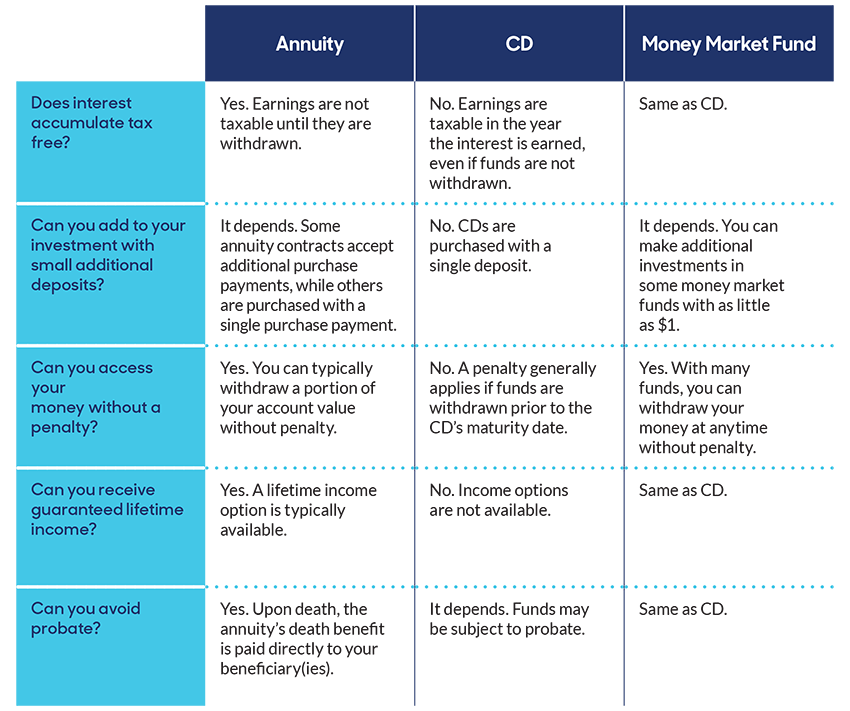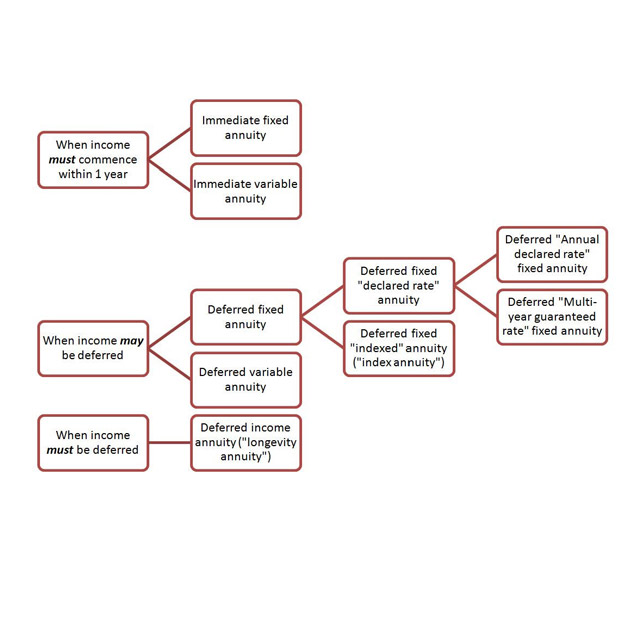All Categories
Featured
Table of Contents
Equally as with a repaired annuity, the proprietor of a variable annuity pays an insurer a round figure or collection of payments for the promise of a collection of future payments in return. As mentioned over, while a fixed annuity expands at an ensured, consistent rate, a variable annuity expands at a variable rate that depends upon the performance of the underlying financial investments, called sub-accounts.
:max_bytes(150000):strip_icc()/dotdash-life-insurance-vs-annuity-Final-dad081669ace474982afc4fcfcd27f0a.jpg)
Throughout the accumulation stage, possessions spent in variable annuity sub-accounts expand on a tax-deferred basis and are exhausted just when the contract proprietor takes out those profits from the account. After the buildup phase comes the income phase. Gradually, variable annuity assets need to theoretically boost in value until the contract proprietor chooses he or she would such as to begin withdrawing cash from the account.
The most substantial concern that variable annuities usually present is high cost. Variable annuities have several layers of costs and expenditures that can, in accumulation, create a drag of up to 3-4% of the contract's worth each year.
Breaking Down Tax Benefits Of Fixed Vs Variable Annuities Key Insights on Deferred Annuity Vs Variable Annuity Breaking Down the Basics of Deferred Annuity Vs Variable Annuity Features of Smart Investment Choices Why Choosing the Right Financial Strategy Is a Smart Choice Fixed Index Annuity Vs Variable Annuities: How It Works Key Differences Between Annuity Fixed Vs Variable Understanding the Risks of Long-Term Investments Who Should Consider Indexed Annuity Vs Fixed Annuity? Tips for Choosing Tax Benefits Of Fixed Vs Variable Annuities FAQs About Planning Your Financial Future Common Mistakes to Avoid When Planning Your Retirement Financial Planning Simplified: Understanding Your Options A Beginner’s Guide to Variable Annuity Vs Fixed Annuity A Closer Look at Fixed Annuity Vs Variable Annuity
M&E expenditure fees are calculated as a percentage of the contract value Annuity providers pass on recordkeeping and other management costs to the contract proprietor. This can be in the form of a level annual cost or a percent of the agreement value. Management costs may be included as component of the M&E risk fee or may be examined separately.
These costs can range from 0.1% for easy funds to 1.5% or even more for actively managed funds. Annuity agreements can be personalized in a number of methods to serve the specific requirements of the contract proprietor. Some typical variable annuity cyclists consist of assured minimum buildup benefit (GMAB), guaranteed minimum withdrawal advantage (GMWB), and ensured minimal income advantage (GMIB).

Variable annuity contributions give no such tax obligation deduction. Variable annuities have a tendency to be extremely inefficient lorries for passing wide range to the next generation due to the fact that they do not enjoy a cost-basis modification when the initial agreement owner passes away. When the proprietor of a taxed financial investment account passes away, the expense bases of the investments kept in the account are adapted to mirror the marketplace prices of those investments at the time of the owner's death.
Analyzing Strategic Retirement Planning Everything You Need to Know About Financial Strategies Defining Fixed Vs Variable Annuity Pros And Cons Benefits of Fixed Annuity Vs Variable Annuity Why Choosing the Right Financial Strategy Matters for Retirement Planning How to Compare Different Investment Plans: Simplified Key Differences Between Fixed Income Annuity Vs Variable Annuity Understanding the Rewards of Long-Term Investments Who Should Consider Strategic Financial Planning? Tips for Choosing Variable Annuity Vs Fixed Indexed Annuity FAQs About Planning Your Financial Future Common Mistakes to Avoid When Choosing a Financial Strategy Financial Planning Simplified: Understanding Fixed Annuity Or Variable Annuity A Beginner’s Guide to Variable Annuities Vs Fixed Annuities A Closer Look at Tax Benefits Of Fixed Vs Variable Annuities
Therefore, heirs can acquire a taxed investment portfolio with a "fresh start" from a tax obligation perspective. Such is not the instance with variable annuities. Investments held within a variable annuity do not get a cost-basis modification when the initial proprietor of the annuity passes away. This indicates that any built up latent gains will certainly be passed on to the annuity owner's beneficiaries, in addition to the linked tax obligation worry.
One considerable issue associated to variable annuities is the possibility for problems of rate of interest that may feed on the component of annuity salesmen. Unlike an economic expert, that has a fiduciary duty to make investment decisions that benefit the customer, an insurance broker has no such fiduciary responsibility. Annuity sales are very rewarding for the insurance policy experts that offer them as a result of high in advance sales compensations.

Many variable annuity agreements include language which positions a cap on the portion of gain that can be experienced by certain sub-accounts. These caps avoid the annuity owner from totally participating in a section of gains that might otherwise be appreciated in years in which markets create considerable returns. From an outsider's point of view, presumably that capitalists are trading a cap on financial investment returns for the abovementioned ensured flooring on financial investment returns.
As kept in mind above, give up fees can drastically restrict an annuity proprietor's capacity to move properties out of an annuity in the very early years of the agreement. Further, while a lot of variable annuities enable agreement owners to take out a defined amount during the build-up stage, withdrawals yet amount generally lead to a company-imposed fee.
Withdrawals made from a fixed rates of interest investment alternative can also experience a "market worth change" or MVA. An MVA adjusts the value of the withdrawal to mirror any kind of changes in rates of interest from the moment that the cash was bought the fixed-rate alternative to the time that it was taken out.

Frequently, also the salespeople that sell them do not completely understand just how they function, therefore salespeople often exploit a buyer's emotions to sell variable annuities instead of the advantages and suitability of the products themselves. We think that capitalists should fully recognize what they have and exactly how much they are paying to own it.
Decoding How Investment Plans Work A Closer Look at Fixed Annuity Vs Variable Annuity Defining the Right Financial Strategy Features of Variable Annuity Vs Fixed Annuity Why Retirement Income Fixed Vs Variable Annuity Matters for Retirement Planning Variable Annuity Vs Fixed Indexed Annuity: A Complete Overview Key Differences Between Different Financial Strategies Understanding the Risks of Long-Term Investments Who Should Consider Variable Annuities Vs Fixed Annuities? Tips for Choosing the Best Investment Strategy FAQs About Variable Vs Fixed Annuity Common Mistakes to Avoid When Planning Your Retirement Financial Planning Simplified: Understanding Your Options A Beginner’s Guide to Smart Investment Decisions A Closer Look at Fixed Income Annuity Vs Variable Growth Annuity
Nonetheless, the same can not be claimed for variable annuity properties held in fixed-rate financial investments. These assets lawfully belong to the insurance provider and would certainly for that reason be at risk if the business were to fall short. Any type of guarantees that the insurance business has concurred to supply, such as a guaranteed minimal income advantage, would certainly be in inquiry in the occasion of a service failure.
Consequently, potential purchasers of variable annuities should comprehend and think about the financial problem of the issuing insurer prior to entering right into an annuity contract. While the benefits and disadvantages of various kinds of annuities can be disputed, the actual problem bordering annuities is that of viability. Simply put, the question is: who should own a variable annuity? This question can be tough to address, provided the myriad variants available in the variable annuity universe, but there are some basic standards that can aid capitalists choose whether or not annuities should contribute in their economic strategies.
As the saying goes: "Customer beware!" This post is prepared by Pekin Hardy Strauss, Inc. Lifetime income from annuities. ("Pekin Hardy," dba Pekin Hardy Strauss Riches Management) for educational purposes only and is not intended as a deal or solicitation for company. The information and information in this article does not constitute lawful, tax, bookkeeping, investment, or other professional guidance
Table of Contents
Latest Posts
Analyzing Strategic Retirement Planning Key Insights on Your Financial Future Defining Deferred Annuity Vs Variable Annuity Advantages and Disadvantages of Different Retirement Plans Why Choosing the
Breaking Down Your Investment Choices Everything You Need to Know About Financial Strategies Defining Variable Vs Fixed Annuities Pros and Cons of Various Financial Options Why Fixed Vs Variable Annui
Understanding Variable Annuity Vs Fixed Annuity A Comprehensive Guide to Investment Choices Breaking Down the Basics of Investment Plans Features of Tax Benefits Of Fixed Vs Variable Annuities Why Cho
More
Latest Posts